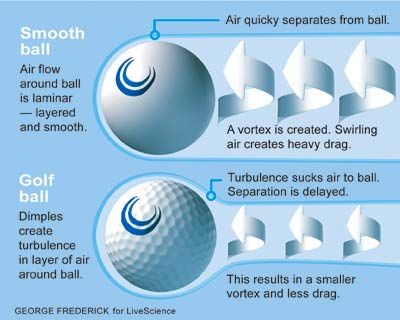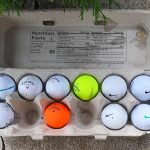Dimples on a golf ball reduce drag and increase lift. This allows the ball to travel farther and more accurately.
Golf balls are designed with dimples to optimize their flight. These small indentations play a crucial role in aerodynamics. They reduce air resistance and enhance lift, allowing the ball to travel longer distances. The dimples create turbulence in the air around the ball, which reduces drag.
This makes the ball more stable and accurate during flight. Understanding the science behind these dimples can help golfers improve their game. Manufacturers continuously study and refine dimple patterns for better performance. So, next time you tee up, remember that those tiny dimples are key to a powerful, accurate shot.

Credit: m.youtube.com
Introduction To Golf Ball Dimples
Golf ball dimples are small, round indentations on the surface of golf balls. They are more than just a design feature. They play a crucial role in the game of golf.
Brief History
Golf balls did not always have dimples. In the early days, they were smooth. Over time, players noticed worn-out balls traveled farther. This led to the discovery that rough surfaces improved ball performance.
By the early 1900s, manufacturers began adding dimples. The first patent for dimpled golf balls was filed in 1905. This innovation revolutionized the game.
Importance In Golf
Dimples on golf balls reduce air resistance. This allows the ball to travel farther. Dimples also create lift, which helps the ball stay in the air longer.
Aerodynamics is the key factor here. The dimples create a thin layer of air around the ball. This reduces drag and increases distance. Golfers rely on this for better shots.
In summary, dimples are essential for golf ball performance. They improve distance, control, and accuracy. Next time you play, remember the science behind those tiny indentations!
The Science Behind Dimples
Golf balls have dimples for a reason. These tiny indentations play a significant role in the ball’s performance. Understanding the science behind dimples can enhance your appreciation of the game.
Aerodynamics
Aerodynamics is the study of how air interacts with objects in motion. Dimples on a golf ball create a thin layer of air that clings to the ball’s surface. This layer helps reduce drag and allows the ball to fly farther.
Without dimples, a golf ball would face more air resistance. This resistance slows the ball down. Dimples create turbulence in the air around the ball. This turbulence reduces the drag force. As a result, the ball travels a longer distance.
Here’s a simple table to illustrate the impact of dimples:
| Ball Type | Drag Force | Flight Distance |
|---|---|---|
| Smooth Ball | High | Short |
| Dimpled Ball | Low | Long |
Physics Of Flight
The physics of flight involves understanding how forces affect a moving object. Dimples change how the air flows around the ball. This change helps in two main ways: reducing drag and increasing lift.
Dimples create a thin boundary layer of air that clings to the ball’s surface. This layer makes the air flow more smoothly. Smooth airflow means less drag. Less drag allows the ball to maintain a higher speed.
Dimples also help generate lift. Lift is an upward force that helps the ball stay in the air longer. The dimples cause the air pressure on the bottom of the ball to be higher than on the top. This pressure difference creates lift.
Here is an unordered list summarizing the benefits of dimples:
- Reduce drag
- Increase lift
- Help the ball fly farther
Understanding these principles can improve your game. Next time you hit the links, think about the science behind those tiny dimples.
How Dimples Affect Distance
Have you ever wondered why golf balls have dimples? These tiny indentations play a crucial role in how far the ball travels. Let’s dive into the science behind dimples and discover how they impact the distance a golf ball can cover.
Drag Reduction
Drag is the resistance a ball faces while moving through the air. Dimples on a golf ball help reduce this drag. How do they achieve this? The dimples create a thin layer of air around the ball. This layer allows the ball to cut through the air more smoothly.
Without dimples, a golf ball would face more air resistance. This would slow it down significantly. By reducing drag, dimples help the ball travel faster and farther.
Lift Enhancement
Lift is another critical factor influenced by dimples. It helps the ball stay in the air longer. Dimples create a turbulent flow of air around the ball. This turbulent flow allows the ball to generate more lift.
More lift means the ball can stay airborne for a longer period. This increased airtime contributes to a greater overall distance.
| Factor | Effect of Dimples |
|---|---|
| Drag | Reduced, allowing the ball to travel faster |
| Lift | Increased, keeping the ball in the air longer |
In summary, dimples reduce drag and enhance lift. These effects combined help a golf ball travel farther. Next time you see a golf ball, you’ll know why those dimples are so important.
Impact On Ball Control
Dimples on a golf ball play a crucial role in ball control. They affect how the ball spins, flies, and lands. Understanding these impacts can improve your game.
Spin Control
Dimples enhance a golf ball’s spin control. They create lift and reduce drag. This allows the ball to spin more effectively. Increased spin helps in making precise shots.
Without dimples, the ball would travel in unpredictable ways. Dimples create a thin layer of air that clings to the ball. This layer helps the ball to cut through the air smoothly. The result is better spin control.
Here’s a simple table to understand the benefits of spin control:
| Aspect | With Dimples | Without Dimples |
|---|---|---|
| Spin Rate | High | Low |
| Shot Accuracy | High | Low |
| Ball Control | Excellent | Poor |
Trajectory Adjustment
Dimples also help in adjusting the ball’s trajectory. They influence how the ball flies through the air. A ball with dimples can achieve a higher, more stable flight path.
This is because dimples reduce air resistance. The ball experiences less drag and can travel further. Golfers can control the height and distance of their shots better.
Here are some key points about trajectory adjustment:
- Dimples help the ball fly higher.
- They reduce drag for a smoother flight.
- They allow for better distance control.
Using a ball with dimples can improve your game significantly. You can achieve more accurate and controlled shots.
Design And Patterns
Golf balls have unique designs and patterns. These designs play a crucial role in their performance. The dimples on a golf ball are not just for looks. They are carefully designed to enhance the ball’s flight and distance.
Dimple Shapes
Dimples on golf balls come in various shapes. The most common shapes include circular, hexagonal, and even teardrop shapes. Each shape affects the ball’s aerodynamics differently. Circular dimples are the most traditional and widely used. Hexagonal dimples can cover more surface area. Teardrop-shaped dimples can reduce drag even further.
Arrangement Variations
The arrangement of dimples on a golf ball is critical. Different patterns and arrangements can change how the ball performs. Some common arrangements include:
- Symmetrical patterns
- Asymmetrical patterns
- Clustered patterns
Symmetrical patterns ensure a balanced flight. Asymmetrical patterns can enhance specific flight characteristics. Clustered patterns can improve spin control.
| Pattern Type | Characteristics |
|---|---|
| Symmetrical | Balanced flight and consistent performance |
| Asymmetrical | Enhanced flight characteristics |
| Clustered | Improved spin control |
The number of dimples also varies. Most golf balls have between 300 to 500 dimples. More dimples can mean better control. Fewer dimples can mean longer distance.
Material And Manufacturing
Understanding the material and manufacturing of golf balls helps explain their unique properties. The dimples on a golf ball are an essential part of its design, impacting its performance significantly. Let’s dive into how the materials and production techniques contribute to this.
Ball Composition
Golf balls are made from different materials. The core of a golf ball is usually made from rubber. The outer shell, called the cover, is made from surlyn or urethane. These materials affect the ball’s durability and performance.
Surlyn is a tough material that makes the ball durable. Urethane is softer, offering better control and spin. The type of cover material affects how the dimples interact with the air.
Production Techniques
Golf ball production involves several steps. First, the core is made by molding rubber into a spherical shape. This core is then covered with a thin layer of synthetic material.
Next, dimples are added using a mold. The mold shapes the outer surface of the ball, creating the dimples. The number and pattern of dimples can vary, impacting the ball’s flight and control.
Here’s a simple overview of the steps:
- Molding the rubber core
- Covering the core with synthetic material
- Adding dimples using a mold
- Final coating and quality check
These production techniques ensure that each golf ball performs optimally. The materials and manufacturing processes work together to enhance the ball’s flight and control, thanks to the dimples.
Comparing Dimpled Vs. Smooth Balls
When comparing dimpled vs. smooth golf balls, the differences are striking. Dimples play a crucial role in a golf ball’s performance. This section delves into how these tiny indentations impact the game.
Performance Differences
Dimples on a golf ball significantly affect its flight. A smooth ball does not travel as far. Why? Because dimples reduce air resistance. A dimpled ball has a better lift and drag ratio. This means it can travel farther and more accurately.
| Feature | Dimpled Ball | Smooth Ball |
|---|---|---|
| Distance | Farther | Shorter |
| Accuracy | Higher | Lower |
| Stability | More Stable | Less Stable |
Practical Implications
Using a dimpled ball can improve your game. Amateurs benefit from the added distance and stability. Professionals rely on these for precise shots. Choosing a smooth ball might hinder performance. In windy conditions, a dimpled ball performs better.
- Increased Distance: Dimpled balls travel farther.
- Better Accuracy: More control over shots.
- Enhanced Stability: Less affected by wind.
In conclusion, dimples are essential for optimal golf performance. They provide numerous benefits that smooth balls cannot. Next time you play, consider the advantages of a dimpled ball.

Credit: www.fenixxcell.com
Future Of Golf Ball Technology
The future of golf ball technology is exciting. Engineers and scientists are pushing boundaries. They are exploring new materials and designs. This innovation promises better performance for players. Let’s dive into some key areas.
Innovative Designs
Golf ball designs are changing rapidly. Engineers are experimenting with dimple patterns. The goal is to improve flight and stability.
New materials are also in play. Some balls have multi-layer constructions. This can enhance control and distance. Here’s a table showing some innovative designs:
| Design Feature | Benefit |
|---|---|
| Hexagonal Dimples | Improved Aerodynamics |
| Multi-Layer Construction | Enhanced Control |
| Soft Cover | Better Feel |
Potential Advances
Future golf balls may use smart technology. Imagine a ball that tracks its own flight. Data could help golfers improve their game.
Eco-friendly materials are another focus. Biodegradable golf balls are being developed. These are better for the environment.
Here are some potential advances:
- Smart Golf Balls
- Biodegradable Materials
- Customizable Aerodynamics
These advances will change how we play golf. They offer exciting possibilities for the future.
Conclusion And Key Takeaways
Understanding the role of dimples on a golf ball can enhance your game. These small indentations are crucial for better performance. Let’s recap the main benefits and final thoughts on this topic.
Summary Of Benefits
- Improved Aerodynamics: Dimples help the ball fly smoother.
- Increased Distance: They allow the ball to travel farther.
- Better Control: Dimples provide more stability in the air.
- Reduced Drag: The design cuts down on air resistance.
- Enhanced Lift: Dimples create lift, making the ball rise.
Final Thoughts
Dimples on a golf ball are not just for looks. They play a vital role in how the ball behaves. This knowledge can help you choose the right ball. It can also improve your playing strategy. So next time you play, remember the dimples!

Credit: golf.com
Frequently Asked Questions
What Do More Dimples On A Golf Ball Mean?
More dimples on a golf ball enhance its aerodynamics. They help reduce drag and increase lift, improving flight distance.
What Do Dimples On Golf Balls Help Increase Speed By Reducing?
Dimples on golf balls help increase speed by reducing aerodynamic drag. This allows the ball to travel further.
How Do Dimples Reduce Drag?
Dimples reduce drag by creating a turbulent boundary layer. This helps the airflow stay attached to the surface longer. As a result, pressure drag decreases, improving efficiency.
What Are The Divots In Golf Balls Called?
The divots in golf balls are called dimples. They enhance the ball’s aerodynamics and improve flight distance and accuracy.
Conclusion
Dimples on a golf ball significantly impact its flight and performance. They reduce air resistance and increase lift. This leads to longer, more accurate shots. Understanding their role can improve your game. Next time you tee off, remember the science behind those tiny dimples.
Happy golfing!





